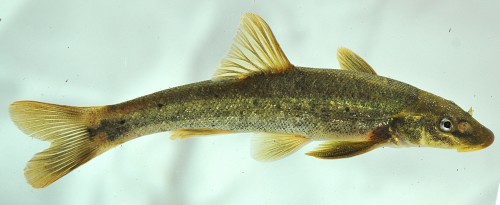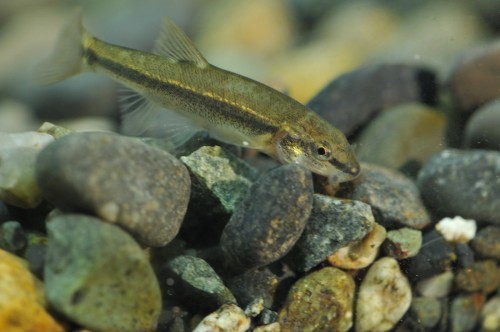Rhinichthys cataractae
Identification Tips:
• Long streamlined body, nearly round in cross-section, but slightly flattened on bottom
• Long snout, with mouth facing downward
• Upper lip is attached to the snout with a fleshy connector (frenum)
• Barbel at corners of mouth
• Fry have horizontal stripe full length of body
• To 15 cm in some populations
• Impossible to distinguish in the field between two forms found found in Fraser Valley Nooksack Dace (Endangered) and Columbia Longnose Dace
Conservation Status:
| British Columbia | Canada | Natureserve | |
| COSEWIC | Species at Risk Act | ||
| Not at Risk (Yellow List) | Not Assessed | None | G5 N5 S5 |
Information Source: BC Conservation Data Centre: http://a100.gov.bc.ca/pub/eswp/
Life History:
• Spawn in spring
• Males prepare a nest, court females and defend eggs until hatch
• Primarily nocturnal
• Feed on a variety of aquatic invertebrates
Habitat:
• Typically found among gravel cobble or boulder in fast flowing areas of rivers and streams
•
• A unique lake-dwelling population occurs along the rocky shores of Chilliwack Lake
Range:
British Columbia
• Found in most rivers of mainland BC
• Absent from north coast rivers except the Skeena and Nass rivers
Global
• Widest geographic range of any North American minnow
• Found from Atlantic to Pacific; Arctic to northern Mexico
Comments:
• Two forms of Longnose Dace Columbia Longnose Dace, and Nooksack • Dace colonized the Fraser Valley after glaciation via different routes
• Nooksack dace are known only from Fraser Valley in Canada: Brunette River, Pepin Creek, Bertrand Creek, Fishtrap Creek
• Columbia Form are in Fraser Valley occur in Fraser River, Coquihalla River and Norrish Creek
Hybrid forms are found in Coquitlam River, Alouette River, Kanaka Creek, and Chilliwack River watershed
––––––
Primary Information Source:
McPhail, J.D. 2007. The Freshwater Fishes of British Columbia. University of Alberta Press. Edmonton, Alberta.


